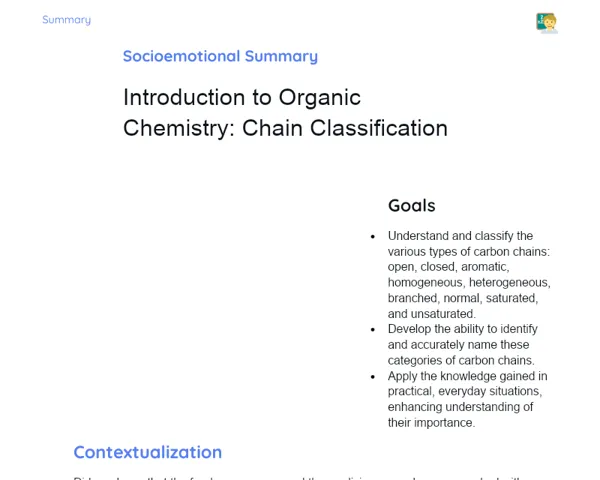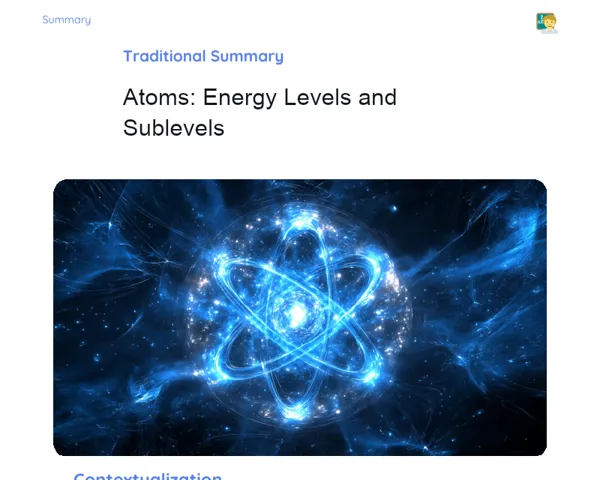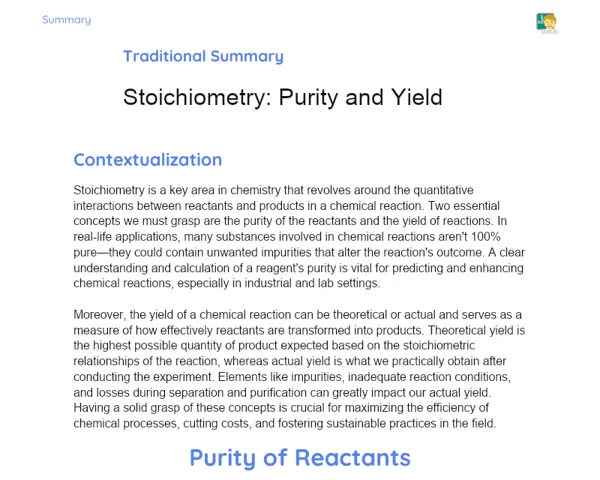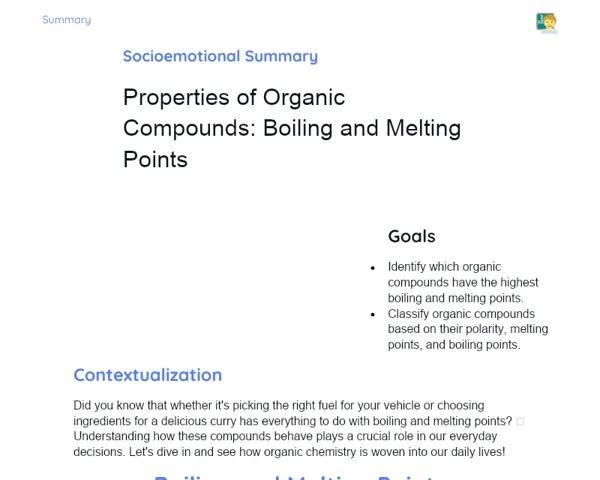Summary Tradisional | Introduction to Organic Chemistry: Orbital Hybridization
Contextualization
Orbital hybridization is a key concept in Organic Chemistry that sheds light on how carbon atoms form their covalent bonds. Carbon, known for its tetravalency, can create four covalent bonds, leading to an impressive variety of compounds. The hybridization of carbon's atomic orbitals takes place when s and p orbitals mix to produce new hybrid orbitals with distinct shapes and energies, facilitating the creation of stable and well-defined molecular structures.
The three primary types of hybridization that carbon can display are sp, sp², and sp³. Each hybridization type yields different molecular geometries and bond angles, which directly affect the physical and chemical characteristics of the resultant molecules. For instance, during sp³ hybridization, carbon adopts a tetrahedral shape, whereas in sp² hybridization, the arrangement is trigonal planar. Grasping these concepts is crucial for studying intricate organic molecules and their chemical interactions.
To Remember!
Introduction to Orbital Hybridization
Orbital hybridization is a fundamental concept in Organic Chemistry that is vital for understanding the mechanism by which carbon atoms form their covalent bonds. This process entails the blending of atomic orbitals, such as s and p orbitals, to create new hybrid orbitals. These hybrid orbitals possess distinct shapes and energy levels compared to their original counterparts, making it possible to form stable and specific molecular setups.
Hybridization plays a significant role in explaining molecular geometry and the chemical reactivity of organic compounds. It aids in comprehending how carbon atoms can forge different types of bonds and molecules exhibiting diverse physical and chemical properties. Additionally, the concept of hybridization elucidates how carbon atoms are arranged in space, which in turn affects the structure and functionality of molecules.
The three main types of carbon hybridization are sp, sp², and sp³, each leading to unique molecular geometries and bond angles that influence the properties of produced molecules. Understanding these notions is essential in the study of advanced organic molecules and their chemical behaviors.
-
Orbital hybridization entails the merging of atomic orbitals to create new hybrid orbitals.
-
The resulting hybrid orbitals exhibit different shapes and energy levels relative to the original atomic orbitals.
-
Carbon undergoes three primary types of hybridization: sp, sp², and sp³.
sp³ Hybridization
In sp³ hybridization, one s orbital fuses with three p orbitals to generate four identical sp³ hybrid orbitals. These hybrid orbitals, having the same energy, exhibit a tetrahedral configuration in space, which is defined by bond angles of about 109.5°. This configuration enables carbon to establish four stable covalent bonds.
A classic representation of sp³ hybridization is methane (CH₄). In methane, the central carbon atom forges four sigma (σ) bonds with four hydrogen atoms. Each sigma bond arises from the overlap of one sp³ orbital from carbon with one s orbital from hydrogen. The tetrahedral structure of methane results in a symmetrical three-dimensional shape, significantly influencing its physical and chemical properties.
sp³ hybridization is prevalent in many organic compounds, especially those featuring carbon atoms with four single bonds. This hybridization is key to understanding the structure and reactivity of a wide range of organic molecules, from simple hydrocarbons to more complex macromolecules.
-
sp³ hybridization leads to the formation of four sp³ hybrid orbitals.
-
The resultant molecular geometry is tetrahedral, with bond angles of around 109.5°.
-
Methane (CH₄) serves as a classic example of sp³ hybridization.
sp² Hybridization
In sp² hybridization, one s orbital combines with two p orbitals to form three sp² hybrid orbitals. These orbitals are equivalent in energy and position themselves in a trigonal planar arrangement, resulting in bond angles of 120°. Additionally, one unhybridized p orbital remains free to take part in pi (π) bond formation.
A classic example of sp² hybridization is ethylene (C₂H₄). In ethylene, each carbon atom produces three sigma (σ) bonds using the sp² hybrid orbitals, while one pi (π) bond is formed with the unhybridized p orbital. The trigonal planar geometry of ethylene adds to the stability of the molecule and shapes its chemical properties, particularly its reactivity during addition reactions.
sp² hybridization frequently appears in organic compounds that contain double bonds between carbon atoms. This hybridization is instrumental in understanding the structure and reactivity of unsaturated molecules, including alkenes and aromatic compounds.
-
sp² hybridization results in the formation of three sp² hybrid orbitals along with one unhybridized p orbital.
-
The resultant molecular geometry is trigonal planar, with bond angles measuring 120°.
-
Ethylene (C₂H₄) serves as a classic example of sp² hybridization.
sp Hybridization
In sp hybridization, one s orbital merges with one p orbital to create two sp hybrid orbitals. These hybrid orbitals are equivalent in energy and align themselves linearly in space, resulting in bond angles of 180°. Additionally, two unhybridized p orbitals remain available for pi (π) bond formation.
A classic example of sp hybridization is acetylene (C₂H₂). In acetylene, each carbon atom forges two sigma (σ) bonds using the sp hybrid orbitals and two pi (π) bonds with the unhybridized p orbitals. The linear configuration of acetylene contributes to the molecule's rigidity and influences its chemical properties, particularly during addition reactions.
sp hybridization is often seen in organic compounds that contain triple bonds between carbon atoms. This hybridization is vital for discerning the structure and reactivity of unsaturated molecules, such as alkynes and acetylenic compounds.
-
sp hybridization leads to the formation of two sp hybrid orbitals and two unhybridized p orbitals.
-
The resulting molecular geometry is linear, featuring bond angles of 180°.
-
Acetylene (C₂H₂) is a prime example of sp hybridization.
Key Terms
-
Hybridization: The process of merging atomic orbitals to produce new hybrid orbitals.
-
sp³ Orbital: A hybrid orbital created from one s and three p orbitals, which results in tetrahedral geometry.
-
sp² Orbital: A hybrid orbital formed by combining one s and two p orbitals, characterized by trigonal planar geometry.
-
sp Orbital: A hybrid orbital formed through the combination of one s and one p orbital, resulting in linear geometry.
-
Tetrahedral Geometry: A molecular structure having bond angles of around 109.5°, typical of sp³ hybridization.
-
Trigonal Planar Geometry: A molecular structure with bond angles of 120°, typical of sp² hybridization.
-
Linear Geometry: A molecular structure characterized by bond angles of 180°, typical of sp hybridization.
-
Sigma (σ) Bond: A covalent bond formed by the direct overlap of atomic orbitals.
-
Pi (π) Bond: A covalent bond formed by the lateral overlap of unhybridized p orbitals.
Important Conclusions
In this session, we delved into the fundamental ideas surrounding orbital hybridization in Organic Chemistry, with a spotlight on the three primary hybridizations of carbon: sp, sp², and sp³. We reviewed how the combination of s and p orbitals creates new hybrid orbitals, leading to distinct molecular geometries and bond angles. Practical examples, including methane (CH₄), ethylene (C₂H₄), and acetylene (C₂H₂), were utilized to illustrate these hybridizations and their resultant effects on the physical and chemical traits of organic molecules.
Comprehending these hybridizations is critical for appreciating the structure and reactivity of organic compounds. The sp³ hybridization produces tetrahedral geometry with bond angles around 109.5°, sp² hybridization leads to a trigonal planar arrangement with bond angles of 120°, and sp hybridization results in a linear configuration with bond angles of 180°. These different spatial alignments significantly affect properties such as solubility, boiling point, and chemical reactivity of molecules.
The insights gained regarding orbital hybridization are vital not just for Organic Chemistry but also for practical applications in fields such as pharmacology and materials science. The contrast between diamond and graphite, both composed of carbon, perfectly exemplifies how hybridization can dramatically alter material properties. We encourage students to further explore these concepts to deepen their understanding of molecular structure and its practical impacts.
Study Tips
-
Review the examples of molecules discussed in class, such as methane (CH₄), ethylene (C₂H₄), and acetylene (C₂H₂), by sketching their structures and identifying the types of hybridization and molecular geometries.
-
Utilize molecular models or modeling software to visualize the various geometries resulting from sp, sp², and sp³ hybridizations. This will greatly aid in understanding how hybrid orbitals are oriented in space.
-
Read articles or book chapters about the application of orbital hybridization in fields like pharmacology, materials science, and nanotechnology to provide a practical perspective on the theoretical knowledge acquired.



